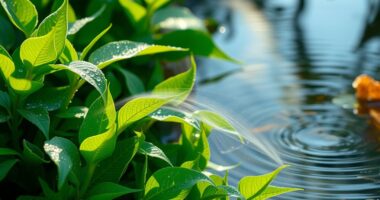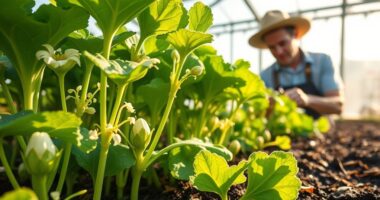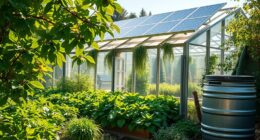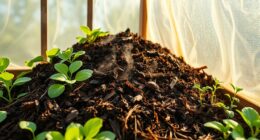Humidity control in greenhouses is crucial for promoting plant health and maximizing yields. It helps prevent diseases, optimizes growth conditions, and can lower energy costs. By maintaining the right humidity levels, you ensure your plants thrive and absorb nutrients efficiently. Plus, proper humidity management enhances light transmission, supporting photosynthesis. Curious about the different methods and technologies for effective humidity control? There’s a lot more to discover about creating the ideal greenhouse environment!
Key Takeaways
- Humidity control prevents diseases and fungal infections, promoting healthier plants and reducing crop losses.
- Maintaining optimal humidity levels enhances plant growth and nutrient absorption, leading to better yields.
- Proper humidity management lowers energy costs by optimizing ventilation and heating systems.
- It improves light transmission, crucial for photosynthesis, ensuring plants receive adequate energy.
- Effective humidity control supports sustainable practices by conserving water and minimizing chemical usage.
Benefits of Humidity Control in Greenhouses

When you effectively control humidity in your greenhouse, you not only prevent diseases but also create an environment that promotes optimal plant growth.
Proper humidity management helps reduce the risk of fungal infections and molds, ensuring your plants thrive. By optimizing ventilation and heating, you save on energy costs while maintaining the ideal climate for your crops.
You can customize conditions to meet specific needs, resulting in stronger plants capable of facing external challenges. Improved air circulation and reduced condensation enhance light transmission, which is crucial for photosynthesis.
Additionally, effective humidity control minimizes safety hazards for workers and contributes to better crop quality, giving you a competitive edge in the market while also promoting sustainable practices.
Ideal Humidity Levels for Optimal Plant Growth

Achieving the right humidity levels is crucial for optimal plant growth in a greenhouse. Most plants thrive with relative humidity between 50% and 80%.
For seedlings, keeping humidity around 70% to 80% helps prevent dehydration, while mature plants flourish at 50% to 70% RH. If you’re growing tropical plants, aim for humidity above 75%.
On the other hand, succulents and similar species prefer drier conditions, typically below 50% RH. Maintaining these ideal humidity levels promotes better nutrient uptake and overall growth.
Methods for Reducing Humidity in Greenhouse Environments

To effectively reduce humidity in greenhouse environments, implementing a combination of ventilation, dehumidifiers, and air circulation techniques is essential.
Start by installing a proper ventilation system to exchange humid air with drier outside air. Adding dehumidifiers can further help by removing excess moisture directly from the air.
Enhance air circulation using fan systems, which prevent stagnant pockets and promote even humidity levels throughout the space.
Consider using heat management strategies, like controlling thermostats and incorporating shade structures, to reduce evaporation rates.
Lastly, practice precise watering techniques and ensure proper condensate drainage to maintain a drier environment.
The Impact of Humidity on Plant Growth and Health

Humidity plays a crucial role in plant growth and health, affecting everything from transpiration to nutrient uptake. When humidity levels are high, transpiration slows, which can lead to nutrient deficiencies. Conversely, low humidity speeds up transpiration, causing rapid water loss and stress for your plants.
Ideally, keeping humidity between 50% and 70% supports optimal conditions for growth. Humidity also influences photosynthesis; high levels may cause stomatal closure, reducing CO2 intake.
Additionally, high humidity creates a breeding ground for diseases and pests, while low humidity can trigger spider mite infestations. By maintaining the right humidity, you enhance nutrient absorption and overall plant health, ensuring better yields and crop quality.
Technologies for Effective Humidity Management

Maintaining optimal humidity levels is vital for plant health, and employing the right technologies can make a significant difference in your greenhouse.
Ventilation systems effectively remove excess moisture, while fogging systems boost humidity and lower temperatures for plants that thrive in damp conditions.
Dehumidification units, like DryGair, recycle air by heating and drying it, which helps manage humidity.
Misting systems are handy for increasing moisture in dry environments.
Automated systems with sensors simplify humidity management, ensuring consistent conditions.
Additionally, using fans, screening fabrics, and shade cloths can enhance air circulation and regulate solar exposure.
Economic and Environmental Benefits of Humidity Control

While effective humidity control might seem like an added expense, it actually offers significant economic and environmental benefits that can enhance your greenhouse operations.
By optimizing ventilation and heating systems, you’ll see reduced energy consumption and lower utility bills. Maintaining ideal humidity levels boosts crop yields and quality, while minimizing the risks of fungal diseases and pests, which cuts down on losses and costly treatments. Additionally, proper humidity management is crucial for maximizing plant growth and health, leading to more fruitful harvests.
Furthermore, efficient humidity management conserves water and reduces the need for chemicals, benefiting the environment. With consistent production quality, you’ll enhance your market competitiveness and build customer trust. Additionally, solar energy solutions can be integrated into your greenhouse systems to further reduce operational costs.
Ultimately, effective humidity control not only increases profitability but also supports long-term sustainability in your greenhouse.
Best Practices for Maintaining Humidity in Greenhouses
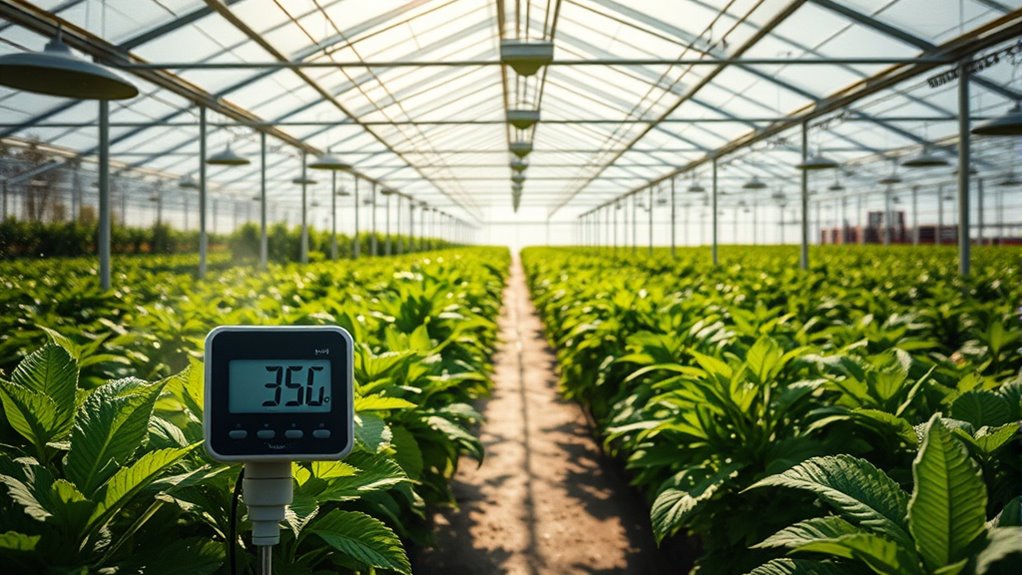
To create a thriving greenhouse environment, it’s essential to implement best practices for humidity management.
Start by monitoring humidity levels with hygrometers or sensors, aiming for a range of 50% to 70%. Use proper ventilation techniques, like installing vents and fans, to promote air circulation and reduce moisture buildup.
Water early in the day, allowing excess moisture to evaporate, and consider drip irrigation to minimize humidity. Maintain a temperature between 60°F to 80°F to help control humidity levels effectively.
For additional control, use dehumidifiers to combat high humidity or humidifiers when it’s too low. Regularly clean your greenhouse to prevent mold and ensure proper drainage to avoid water accumulation.
These steps will help your plants thrive.
Frequently Asked Questions
How Does Humidity Affect Different Plant Species Differently?
Humidity affects plant species in various ways because each type has unique adaptations.
For instance, C4 plants like maize thrive in lower humidity, using water efficiently. In contrast, C3 plants such as wheat may struggle in dry conditions.
High humidity can enhance photosynthesis for certain species but may also increase disease risk.
You’ll notice that some plants, like ferns, flourish in moist environments, while succulents prefer drier conditions, highlighting their diverse needs.
Can Humidity Levels Influence Pest Populations in Greenhouses?
Absolutely, humidity levels can significantly influence pest populations in greenhouses.
When humidity’s high, pests thrive and reproduce more rapidly, making them tougher to manage. Excess moisture creates ideal conditions for pests, leading to larger infestations.
Furthermore, high humidity can hinder beneficial organisms that naturally control pests, allowing those populations to grow unchecked.
Thus, monitoring and adjusting humidity is crucial to maintaining a balanced ecosystem in your greenhouse.
What Are the Signs of Improper Humidity Levels?
Imagine your plants throwing a humidity-themed party, but they forgot to check the guest list.
Signs of improper humidity show up when you spot condensation making walls look like they’re sweating, or when your plants start wilting like they just heard bad news.
You might find unwanted guests like mold or insects crashing the bash, while light struggles to break through the haze.
Keep an eye out; it’s a chaotic, unhealthy gathering!
How Often Should Humidity Be Monitored in Greenhouses?
You should monitor humidity in your greenhouse daily to ensure it stays within the optimal range.
Real-time data is crucial, so consider using automated systems that provide continuous updates. These systems can alert you to any deviations, allowing you to respond quickly.
During seasonal changes, you might need to adjust your monitoring frequency. Regular checks, even manual ones, help validate sensor data and ensure your plants thrive without stress.
Are There Natural Methods to Control Humidity in Greenhouses?
You’ve got a delicate dance to perform when it comes to humidity in your greenhouse.
To keep things balanced, try venting out that sticky air and letting in some refreshing breezes. You can also circulate air to prevent those pesky moisture pockets.
For a touch of tranquility, consider misting or placing water trays to create a serene atmosphere.
And don’t forget to keep those floors dry for a smoother operation!
Conclusion
In today’s fast-paced world, controlling humidity in your greenhouse isn’t just a nice-to-have; it’s essential for thriving plants and a successful operation. By maintaining optimal humidity levels, you’re not only boosting plant health but also enhancing your yield and saving on resources. As you implement the best practices and technologies available, you’ll create a more sustainable environment. Remember, a little moisture control can go a long way—just like a smartphone transformed communication!


